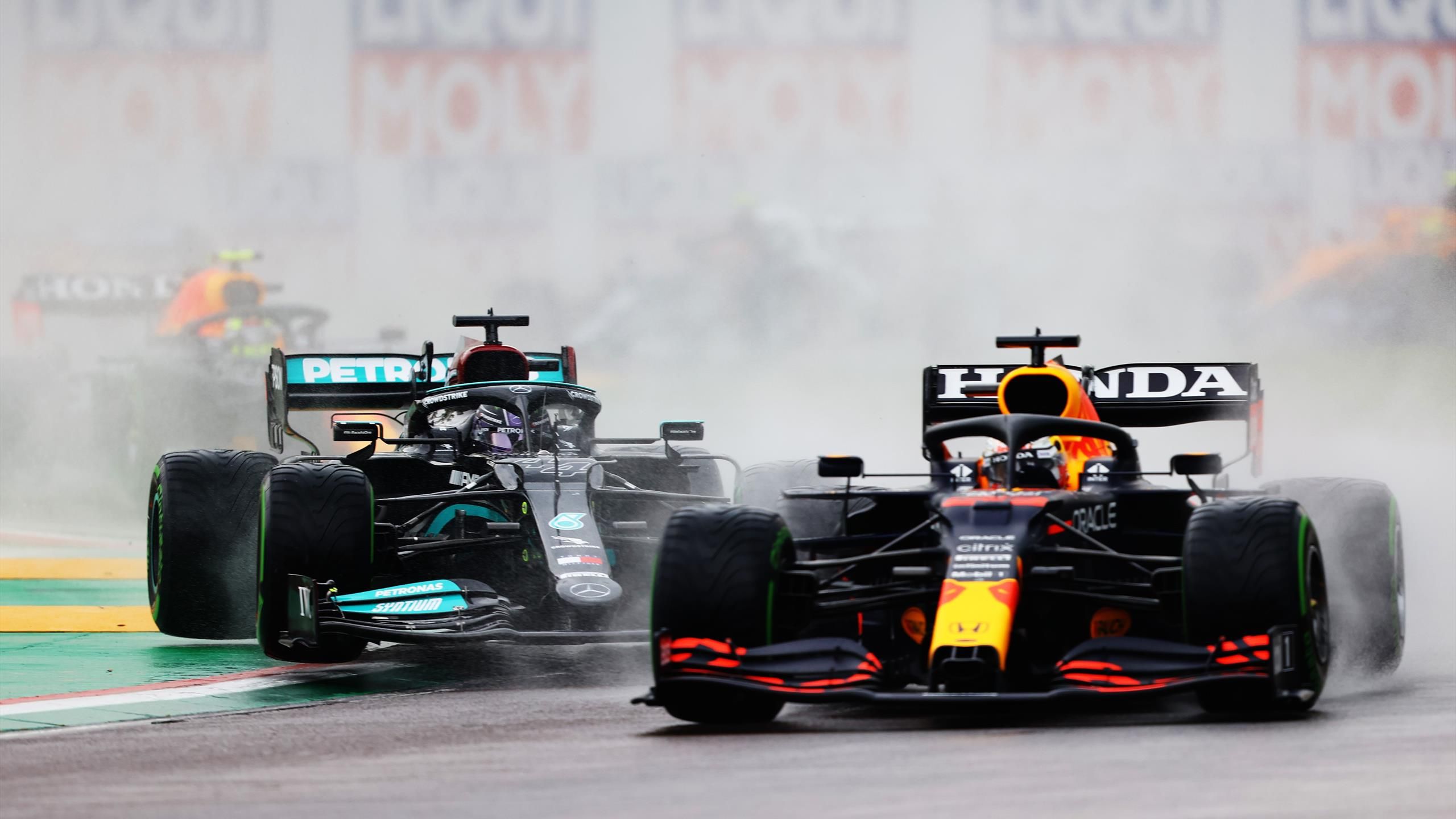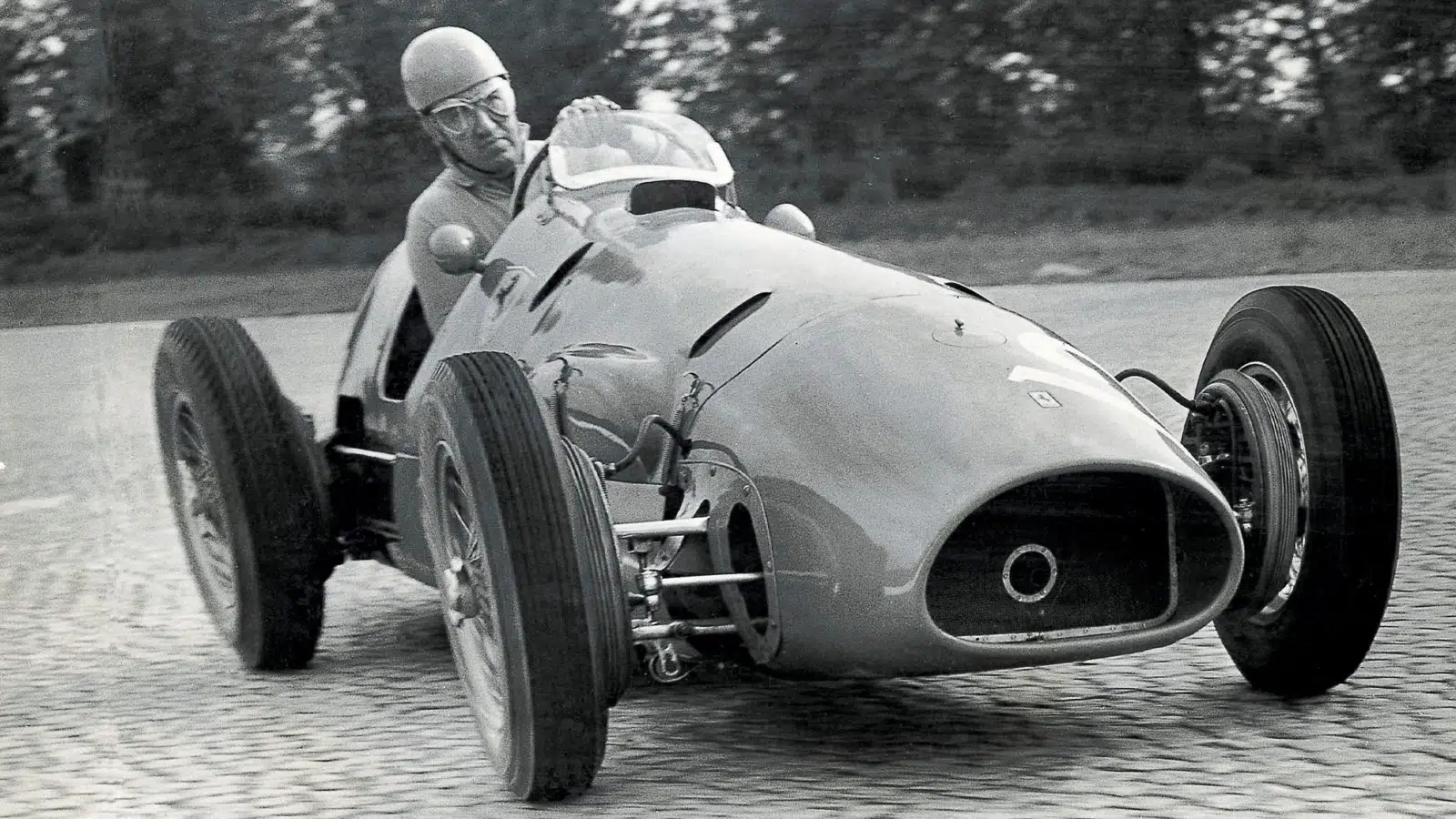
Alberto Ascari – 10 Answers
The sport of Formula 1 is rich with history, filled with legends whose names are still whispered in hallowed tones by the race aficionados. One such legendary figure is Alberto Ascari. A titan in his own right, Ascari’s legacy in F1 is undeniable. This comprehensive guide will address some of the most commonly asked questions about this iconic driver. Delve deep into his life, achievements, and the legacy he left behind, exclusively at Formula1Review.
Who was Alberto Ascari and why is he significant in Formula 1 history?
Alberto Ascari, born on 13th July 1918, was an Italian racing driver and is widely considered as one of the most dominant figures in the early days of Formula 1. His significance isn’t merely restricted to statistics; it’s deeply entrenched in the manner he raced and dominated during his era.
- Ascari began his racing career post the Second World War and quickly established himself as a force to be reckoned with. His style was aggressive yet precise, which made him both a crowd favorite and a formidable opponent on the track.
- He raced for Scuderia Ferrari, among other teams, and his association with Ferrari established a bond that saw some of the most thrilling races of the time.
- Ascari was the first ever driver to win back-to-back World Championships in 1952 and 1953. This achievement set a precedent for the champions that followed.
- His dominance in the 1952 season was evident, as he won 6 out of the 7 races he participated in. This was an astonishing feat, especially considering the competitive nature of the sport.
- Beyond his wins and podiums, Ascari was known for his meticulous approach towards the sport. He was known to study tracks in depth and worked closely with his team to ensure the car was optimized for his driving style.
- Tragically, Ascari’s life was cut short when he met with an accident in 1955 during a test drive. His death was a significant loss to the F1 community, but his legacy was already cemented by then.
- Many of Ascari’s records held for decades, only to be broken by modern legends of the sport. This speaks volumes about his skill and the era he raced in.
- Besides his on-track achievements, Ascari played a pivotal role in popularizing Formula 1 in Italy. His success, combined with Ferrari’s legacy, made F1 a national obsession.
- Ascari’s legacy is still remembered and celebrated today. The Autodromo Nazionale Monza, one of the most iconic tracks in F1, named one of its chicanes “Variante Ascari” in his honor.
- In the annals of F1 history, Ascari will always be remembered not just for the races he won but for the indomitable spirit and passion he brought to the track. For more insights into Formula 1’s glorious history, visit the Formula1Review Blog.
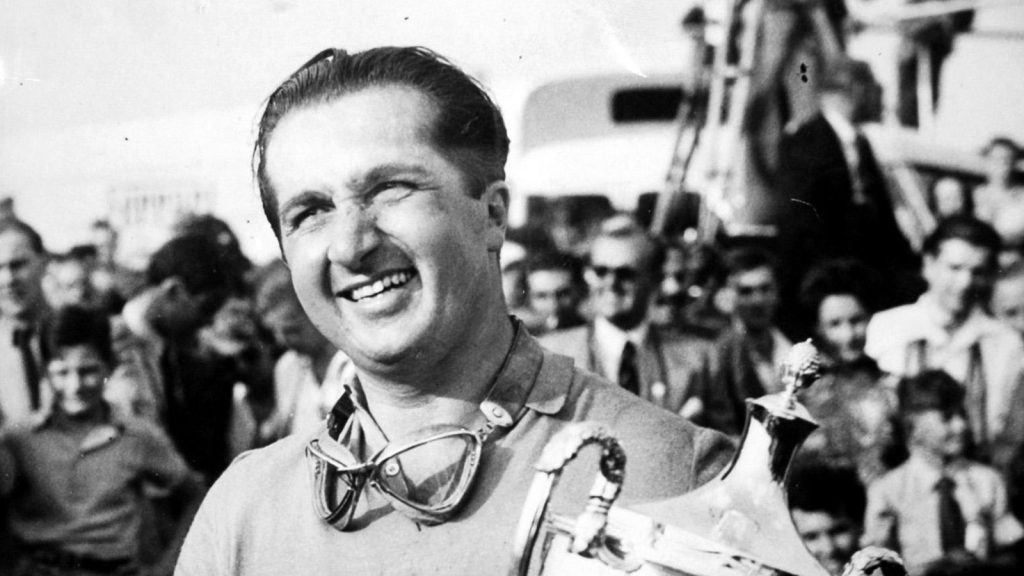
How did Ascari’s driving style compare to his contemporaries?
Racing in the 1950s was fundamentally different from the technologically-driven sport we see today. The cars were raw, the tracks unforgiving, and the risks high. Within this context, Ascari’s driving style stood out, even among a grid of legends.
- Aggression with Finesse: Ascari was known for his aggressive driving style. But what set him apart was his ability to combine this aggression with finesse. While he could dive into corners and battle it out in tight situations, he also had the precision that ensured he didn’t end up in unnecessary skirmishes.
- Technical Acumen: Alberto had an acute understanding of his car’s mechanics. This allowed him to adapt his driving style based on the car’s performance during a race, giving him an edge over others who might have been more reliant on their team’s guidance.
- Consistency: Even amongst his contemporaries, Ascari was known for his consistent lap times. This consistency often meant that while others would have moments of brilliance followed by mistakes, Ascari would steadily build a lead.
- Defensive Driving: When in the lead, Ascari was a master at defensive driving. His ability to hold off challengers, even in inferior machinery, was a testament to his racing intelligence and spatial awareness.
- Track Mastery: Alberto was known to spend a significant amount of time understanding each track’s nuances. This deep knowledge allowed him to exploit certain sections of the track better than his contemporaries.
- Adaptability: Whether it was racing in the wet or dry, on fast tracks or twisty circuits, Ascari had the ability to adapt his driving to suit the conditions. This made him a formidable opponent in any situation.
- Risk Management: While the 1950s saw many daring overtakes and moves, Ascari had a knack for understanding when to push and when to hold back. This risk management often ensured he finished races while others didn’t.
- Relationship with the Car: Ascari had a deep bond with his machinery. He often talked about understanding the car’s “soul”. This relationship allowed him to push the car to its limits without overstepping the mark.
- Rivalries: Like any great sportsman, Ascari had his rivals. Juan Manuel Fangio, another legend of the era, was one such rival. Their battles on track were epic, but Ascari’s style was distinctly different, being more aggressive yet controlled compared to Fangio’s smooth precision.
- Legacy: While many drivers of his era were known for specific strengths, Ascari’s all-rounded style set him apart. He wasn’t just good at one thing; he was great at everything. And this made him a champion.
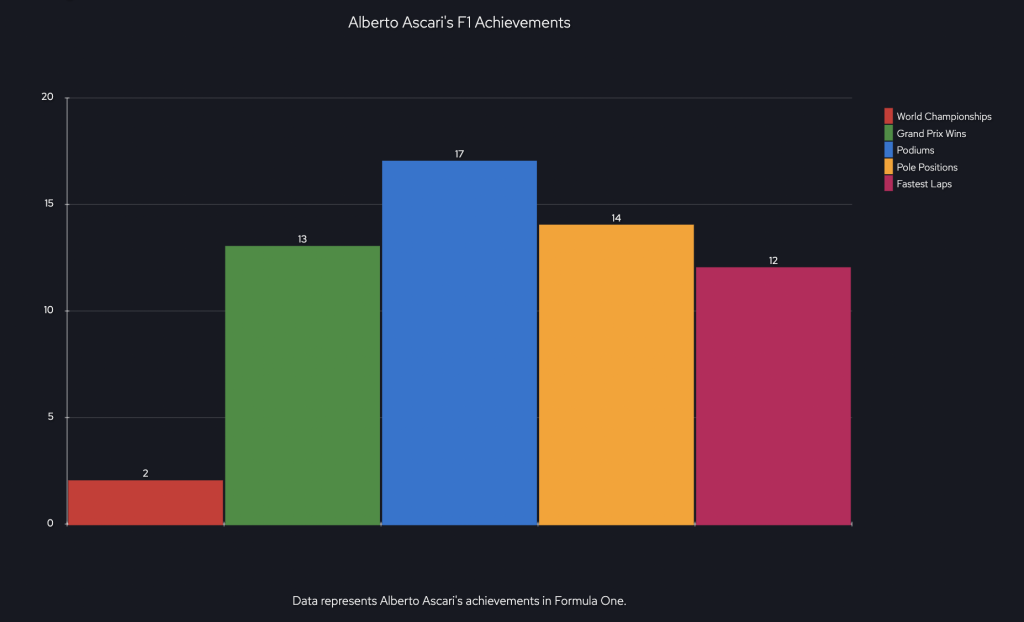
What impact did Ascari’s career have on Italian motorsport?
The influence of Alberto Ascari on Italian motorsport cannot be understated. His success at the pinnacle of motor racing not only brought pride to the nation but also significantly impacted Italy’s motorsport culture.
- National Pride: Ascari’s successes in Formula 1 came during a time when Italy was recovering from the wounds of World War II. His victories became a symbol of national pride and resilience.
- Ferrari’s Golden Boy: Racing predominantly for Ferrari, Ascari became synonymous with the Scuderia’s early successes. His back-to-back world championships in 1952 and 1953 solidified Ferrari’s position as a dominant force in F1.
- Racing Boom in Italy: Ascari’s dominance in the early 1950s played a significant role in the boom of motorsport popularity in Italy. His success led to an increased interest in racing, from grassroots levels to the professional circuits.
- Inspiration to Future Drivers: Alberto Ascari inspired a generation of Italian racers. His achievements showed aspiring drivers that it was possible for an Italian to dominate on the world stage.
- Infrastructure Development: His success indirectly spurred the development of racetracks and motorsport facilities in Italy. Tracks like Monza became hallowed grounds for racers, and newer facilities were developed to cater to the growing interest.
- Cultural Impact: Ascari became a cultural icon in Italy. His life and career were discussed not just in sporting circles but also in cafes, homes, and artistic endeavors. Songs, movies, and art were created celebrating his achievements.
- Safety Advocacy: Although motorsport during Ascari’s time was fraught with danger, his unfortunate accident led to increased discussions about driver safety in Italy, influencing future safety measures in the sport.
- Economic Influence: The rise in motorsport’s popularity, driven in part by Ascari’s success, also had an economic impact. Manufacturers, sponsors, and businesses saw the potential in aligning with racing teams and events.
- Tourism Boost: With Ascari’s fame and the popularity of F1 races, Italy saw an influx of tourists wanting to experience the thrill of races, especially at iconic tracks like Monza.
- Legacy: Ascari’s impact on Italian motorsport is still felt today. While Italy has produced many great drivers since, Ascari’s influence as a pioneering champion remains unmatched.
How did Ascari’s relationship with Enzo Ferrari shape his career?
Alberto Ascari’s relationship with Enzo Ferrari, the founder of Scuderia Ferrari, was instrumental in shaping his F1 career. Their association wasn’t just a driver-team owner dynamic; it was deeper and more intricate.
- Initial Association: Ascari’s association with Ferrari began in the early stages of his career. Both men shared a deep passion for racing, which formed the foundation of their relationship.
- Trust and Belief: Enzo Ferrari had immense trust in Ascari’s abilities. This faith allowed Ascari the freedom to drive aggressively, knowing he had the full support of the team behind him.
- Shared Vision: Both Ascari and Ferrari shared a vision of making Ferrari the most dominant team in Formula 1. Their combined efforts during the early 1950s helped realize this vision, with Ferrari becoming the team to beat.
- Technical Collaboration: Ascari’s technical knowledge and feedback were invaluable to Ferrari. Their collaboration ensured that the cars were tailored to Ascari’s driving style, giving him an edge over his competitors.
- Challenges: Like any relationship, Ascari and Ferrari had their challenges. There were times when they disagreed on strategies or decisions, but their mutual respect ensured these disagreements didn’t derail their association.
- Support During Difficult Times: Ferrari stood by Ascari during tough times. Whether it was a run of bad results or personal challenges, the support from Ferrari played a crucial role in Ascari’s resilience and eventual success.
- Role Beyond Racing: Ascari’s association with Ferrari wasn’t limited to just racing. He was often involved in car development, testing, and other off-track activities that showcased the depth of their relationship.
- Legacy Building: The Ascari-Ferrari duo played a significant role in building Ferrari’s legacy in F1. The early successes, titles, and memorable races laid the foundation for what Ferrari represents in F1 today.
- End of Association: Ascari’s relationship with Ferrari did eventually come to an end, but by then, both had left an indelible mark on each other’s careers.
- Enduring Legacy: Today, when motorsport enthusiasts speak of Ferrari’s golden era, Ascari’s name is invariably mentioned. His relationship with Enzo Ferrari remains one of the most iconic partnerships in F1 history.
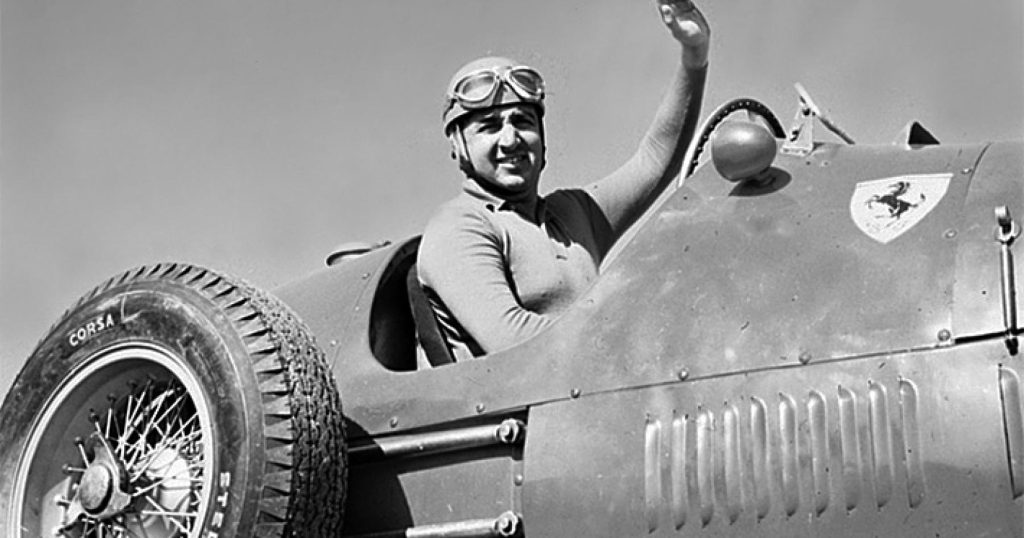
Why is Alberto Ascari often compared to other racing legends like Fangio?
Alberto Ascari’s skills, achievements, and influence on the sport naturally draw comparisons to other racing legends, notably Juan Manuel Fangio. The 1950s was a golden era of racing, with multiple legends on the grid, and the comparisons are inevitable.
- Era of Dominance: Both Ascari and Fangio dominated the early years of Formula 1. Ascari’s back-to-back championships in 1952 and 1953 were followed by Fangio’s own string of titles.
- Driving Mastery: Both drivers showcased unparalleled skills on the track. Whether it was the art of overtaking, defending positions, or understanding their cars, both were masters of their craft.
- Team Associations: Both Ascari and Fangio drove for multiple teams, including Ferrari. Their versatility across different machinery further cements their legendary status.
- Race Wins: In terms of sheer numbers, both Ascari and Fangio racked up numerous race wins and podium finishes, often competing against each other for top honors.
- Rivalry: The on-track battles between Ascari and Fangio are the stuff of legends. Their duels showcased the pinnacle of racing skills, strategy, and sportsmanship.
- Influence on the Sport: Both drivers played significant roles in popularizing Formula 1 globally. Their successes, stories, and personalities attracted fans worldwide.
- Legacy in their Homelands: Ascari for Italy and Fangio for Argentina became national heroes. They carried the hopes and dreams of their nations every time they raced.
- End of Career: Tragically, Ascari’s life and career were cut short due to an accident. In contrast, Fangio raced until he chose to retire, but both left lasting legacies.
- Motorsport Evolution: Both drivers contributed to the evolution of motorsport. Their feedback, skills, and demands from their machinery played roles in car development and the progression of the sport.
- Enduring Comparisons: While many drivers from various eras are compared, the Ascari-Fangio comparison endures because they raced in the same era, often against each other, setting the gold standard for what a racing legend should embody.
What were some of the most memorable races of Ascari’s career?
Alberto Ascari, throughout his illustrious career, had several races that etched his name in the annals of F1 history. These races showcased his skills, determination, and the spirit of a champion.
- 1952 Belgian Grand Prix: Ascari showcased his dominance by securing pole position, setting the fastest lap, and winning the race. It was a perfect display of his racing prowess.
- 1953 German Grand Prix: Racing at the iconic Nürburgring, Ascari had a memorable duel with Juan Manuel Fangio. Despite challenges, he emerged victorious, cementing his status as the season’s dominant driver.
- 1952 French Grand Prix: Ascari, driving for Ferrari, led the race from start to finish. This win was significant as it played a pivotal role in his championship-winning season.
- 1953 British Grand Prix: At Silverstone, Ascari had a tight battle with the likes of Fangio and Mike Hawthorn. While he didn’t win, his performance was a testament to his skills and determination.
- 1952 Italian Grand Prix: Racing on home soil at Monza, Ascari didn’t disappoint his fans. He secured a dominant win, much to the joy of the Italian crowd.
- 1953 Argentine Grand Prix: In a challenging race with changing conditions, Ascari showcased his adaptability and racing intellect to secure a crucial victory.
- 1951 German Grand Prix: Though not a victory, this race was significant. Ascari, driving for Ferrari, battled hard and finished second, showcasing his grit against a competitive field.
- 1950 Monaco Grand Prix: One of his early significant races, Ascari finished second. This race was an indication of the success that was to follow in his career.
- 1954 San Marino Grand Prix: This race was significant as it marked Ascari’s move to Lancia. Though he faced challenges, his performance was commendable given the circumstances.
- 1955 Monaco Grand Prix: Tragically, this would be Ascari’s last race. He crashed into the harbor, but miraculously survived. Sadly, just days later, he would lose his life in a testing accident.
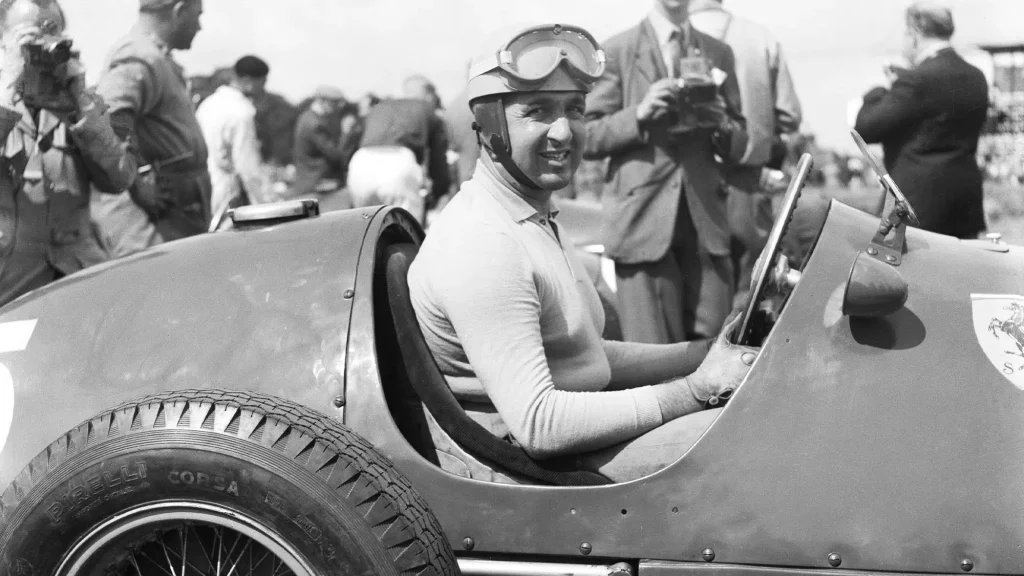
How did Alberto Ascari’s untimely death impact Formula 1 and motorsport in general?
The untimely and tragic death of Alberto Ascari in 1955 sent shockwaves through the motorsport community. Being one of the most prominent figures in racing at the time, his loss had profound implications.
- Immediate Grief: Ascari’s death was mourned worldwide. The motorsport community, fans, and even those who weren’t closely associated with racing felt the weight of the tragedy.
- Safety Concerns: Ascari’s accident reignited concerns over safety in motorsport. There was a renewed demand for better safety measures for drivers, teams, and spectators.
- Impact on Ferrari: Ferrari, having been closely associated with Ascari, felt his loss deeply. The team’s dynamics and performances were impacted in the immediate aftermath.
- Legacy Cemented: While Ascari’s legacy was already significant, his untimely death further immortalized him in motorsport history. Discussions, tributes, and honors were bestowed posthumously.
- Motorsport’s Dangerous Era: Ascari’s death was a grim reminder of the dangers of motorsport in the 1950s. It led to introspection within the community about the inherent risks and the need for change.
- Monza’s Curse: Myths and stories began circulating about a “Curse of Monza.” Ascari’s death, combined with other tragic events at the circuit, led to superstitions about the track.
- Push for Regulations: The FIA and other governing bodies faced pressure to introduce more stringent safety regulations in the wake of Ascari’s accident.
- Memorials and Tributes: Numerous memorials, statues, and events were organized in honor of Ascari. Tracks, corners, and even championships were named after him.
- Family’s Withdrawal: The Ascari family, having lost Alberto’s father Antonio Ascari to racing as well, retreated from active participation in motorsport.
- Historical Perspective: Over time, Ascari’s death became a critical point in motorsport history books. It served as a reference for discussions on safety, the evolution of the sport, and the price of its early days’ glory.
How is Ascari remembered in today’s motorsport community?
Even several decades after his death, Alberto Ascari’s name resonates within the motorsport community. His achievements, personality, and legacy ensure he remains a celebrated figure in F1 history.
- Statues and Monuments: In various parts of Italy, statues and monuments dedicated to Ascari stand tall. They are constant reminders of his contribution to the sport.
- Track Dedications: Certain sections of racetracks, especially in Italy, bear Ascari’s name. For instance, the “Ascari Chicane” at Monza is named in his honor.
- Racing Schools and Foundations: To nurture young talent and keep Ascari’s legacy alive, several racing schools and foundations have been set up in his name.
- Documentaries and Biographies: Ascari’s life and career have been chronicled in numerous documentaries and biographies. They provide insights into his persona, both as a racer and an individual.
- Motorsport Discussions: In discussions about the greatest F1 drivers of all time, Ascari’s name frequently comes up. Experts and fans alike reminisce about his skills and achievements.
- Merchandise and Collectibles: From apparel to scale models, Ascari’s memorabilia remains popular among motorsport enthusiasts. Collectors value items associated with him.
- Team Tributes: Teams, especially Ferrari, often pay tributes to Ascari during special occasions or anniversaries. His association with the Scuderia remains a significant part of their history.
- Motorsport Museums: Museums dedicated to motorsport around the world feature sections or exhibits dedicated to Alberto Ascari, showcasing his cars, gear, and memorabilia.
- Fan Clubs: Dedicated fan clubs and online communities exist where fans of Ascari come together to celebrate his life, share stories, and keep his memory alive.
- Racing Events: Certain racing events, especially in Italy, are organized in memory of Ascari. They serve to celebrate his contribution to the sport and inspire the next generation of racers.
Alberto Ascari’s Formula 1 Achievements
| Year | Grand Prix | Team | Result | Points |
|---|---|---|---|---|
| 1950 | Monaco GP | Ferrari | 2nd | 6 |
| 1952 | Belgian GP | Ferrari | 1st | 9 |
| 1952 | French GP | Ferrari | 1st | 9 |
| 1952 | British GP | Ferrari | 1st | 9 |
| 1952 | German GP | Ferrari | 1st | 9 |
| 1953 | Dutch GP | Ferrari | 1st | 9 |
| 1953 | British GP | Ferrari | 1st | 9 |
| 1953 | Swiss GP | Ferrari | 1st | 9 |
| 1954 | Italian GP | Ferrari | 6th | 1 |
| 1955 | Monaco GP | Ferrari | DNF | 0 |
Note: The above table showcases a selection of Ascari’s performances in Formula 1 and is not exhaustive.
What role did Ascari play in popularizing motorsport in Italy?
Italy has a rich motorsport history, and Alberto Ascari played a pivotal role in enhancing its popularity during his time. His successes and persona had a significant influence.
- National Hero: Ascari’s successes in F1 made him a national hero in Italy. Every victory was celebrated not just in the racing community but by the entire nation.
- Inspiration for Young Drivers: Ascari’s achievements inspired a whole generation of young Italian drivers to pursue a career in motorsport. He became a role model for many aspiring racers.
- Boost to Italian Teams: Ascari’s association with Italian teams, especially Ferrari, provided a significant boost to their popularity and success. His victories were seen as victories for Italy.
- Increased Fan Engagement: With Ascari’s successes, there was a noticeable surge in fan engagement in Italy. More fans flocked to tracks, and the viewership for races increased.
- Promotion of Italian Tracks: Ascari’s popularity also brought attention to iconic Italian tracks like Monza. These tracks became pilgrimage sites for motorsport fans.
- Media Attention: The Italian media extensively covered Ascari’s races, victories, and life. This media attention played a role in popularizing motorsport in the country.
- Economic Boost: With the rise in motorsport’s popularity, there was also an economic benefit. Sponsors, manufacturers, and businesses saw potential in associating with the sport.
- Support for Grassroot Levels: Ascari’s success story highlighted the importance of nurturing talent at the grassroots level. It led to increased support and investment in junior racing series in Italy.
- Enhanced Global Recognition: Ascari’s achievements on the global stage enhanced Italy’s reputation in motorsport. Italy was seen as a powerhouse in F1 and other racing disciplines.
- Legacy Building: The foundation laid by Ascari in terms of popularizing motorsport in Italy is still felt today. Current teams, drivers, and events owe a lot to the momentum generated during Ascari’s era.
How did Ascari’s racing style differ from his contemporaries?
Alberto Ascari had a distinct racing style, which set him apart from his contemporaries. Analyzing his style provides insights into what made him a two-time world champion.
- Smooth Driving: Ascari was known for his smooth driving style. Unlike some of his contemporaries, he believed in conserving his car and tires, ensuring they lasted the race’s duration.
- Technical Acumen: Ascari had a deep understanding of his car’s mechanics. This knowledge allowed him to adapt his driving based on the car’s condition and the track’s demands.
- Consistency: One of Ascari’s significant strengths was his consistency. He could maintain competitive lap times throughout the race, which often gave him an edge.
- Strategic Overtakes: Ascari wasn’t reckless when it came to overtaking. He would patiently wait for the right moment, ensuring minimal risk to himself and his car.
- Calm Under Pressure: Even in high-pressure situations, Ascari remained calm and composed. This trait allowed him to make informed decisions during races.
- Adaptive: Ascari could quickly adapt to varying track conditions and situations. Whether it was rain or mechanical issues, he could adjust his driving style to suit the circumstance.
- Close Bond with Mechanics: Unlike some drivers who maintained a distance from their team’s technical side, Ascari had a close bond with his mechanics. This relationship helped in fine-tuning the car to his preferences.
- Analytical Approach: Ascari was known to study tracks, opponents, and race situations meticulously. His analytical approach to racing gave him an advantage over many of his contemporaries.
- Defensive Driving: When leading a race, Ascari was adept at defensive driving. He could fend off challenges from rivals efficiently, ensuring he maintained his position.
- Risk Management: Ascari was known to balance aggression with caution. He took risks when necessary but was also aware of the importance of finishing races.
In summary, Alberto Ascari’s contributions to motorsport are vast and significant. His impact on Formula 1, especially in its formative years, has left an indelible mark. His legacy is celebrated, remembered, and revered by fans and experts alike.



